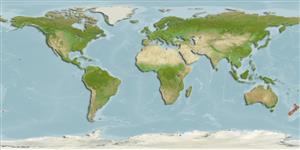Environment: milieu / climate zone / depth range / distribution range
Ecologia
marinhas demersal; intervalo de profundidade 0 - 12 m (Ref. 84085). Temperate
Southwest Pacific: throughout New Zealand, excluding Three Kings Islands.
Tamanho / Peso / Idade
Maturity: Lm ? range ? - ? cm
Max length : 9.4 cm SL macho/indeterminado; (Ref. 13227)
Descrição breve
Chaves de identificação | Morfologia | Morfometria
Espinhos dorsais (total) : 23 - 28; Raios dorsais moles (total) : 13 - 15; Espinhos anais: 1 - 2; Raios anais moles: 24 - 27; Vértebras: 43 - 45. Sloping snout profile, concave or (rarely) steep. Line from tip of premaxilla continued beyond ventral margin of orbit crossing preoperculum or touching its dorsal extremity. No groove
in front of first dorsal fin, although medial sensory pore sits at base of depression; nape naked or with superficial or embedded cycloid scales. Dorsal fin formula V-0N-0-1-0-1(35). Nine procurrent rays in upper lobe, seven in lower lobe; in upper caudal lobe, one large ray between upper lobe and posterior epural, six rays opposite epurals, one ray opposite neural spine of third preural vertebra, one ray anterior to neural spine of third preural vertebra; in lower caudal lobe, six rays opposite haemal spine of second preural vertebra, one ray opposite haemal spine of third preural vertebra (Ref. 84085).
Facultative air-breathing in the genus (Ref. 126274); Adults are found on sheltered coastal reefs and rock and shell substrata in bays and harbors; from intertidal pools to at least 12m (Ref. 84085). They feed on small benthic organisms. Prey is stalked and swallowed whole (Ref. 26966). Eggs are hemispherical and covered with numerous sticky threads that anchor them in the algae on the nesting sites (Ref. 240). Larvae are planktonic which occur primarily in shallow, nearshore waters (Ref. 94114).
Life cycle and mating behavior
Maturidade | Reprodução | Desova | Ovos | Fecundidade | Larvas
Fricke, R., 1994. Tripterygiid fishes of Australia, New Zealand and the southwest Pacific Ocean (Teleostei). Theses Zool. 24:1-585. (Ref. 13227)
Categoria na Lista Vermelha da IUCN (Ref. 130435: Version 2024-2)
Ameaça para o homem
Harmless
Utilização humana
Pescarias: sem interesse
Ferramentas
Relatórios especiais
Descarregue XML
Fontes da internet
Estimates based on models
Preferred temperature (Ref.
123201): 13 - 18.7, mean 16.1 °C (based on 117 cells).
Phylogenetic diversity index (Ref.
82804): PD
50 = 0.5039 [Uniqueness, from 0.5 = low to 2.0 = high].
Bayesian length-weight: a=0.00617 (0.00288 - 0.01322), b=3.04 (2.86 - 3.22), in cm total length, based on LWR estimates for this (Sub)family-body shape (Ref.
93245).
Nível Trófico (Ref.
69278): 3.3 ±0.0 se; based on diet studies.
Resiliência (Ref.
120179): Elevada, tempo mínimo de duplicação da população menor que 15 meses (Preliminary K or Fecundity.).
Fishing Vulnerability (Ref.
59153): Low vulnerability (10 of 100).
Nutrients (Ref.
124155): Calcium = 167 [89, 427] mg/100g; Iron = 0.682 [0.361, 1.352] mg/100g; Protein = 18 [17, 19] %; Omega3 = 0.397 [0.177, 0.880] g/100g; Selenium = 9.75 [3.92, 23.81] μg/100g; VitaminA = 15.3 [3.5, 66.4] μg/100g; Zinc = 1.15 [0.73, 1.77] mg/100g (wet weight);
